Release Date :
Reference Number :
2017-20
The Livestock and Poultry production in Region I posted a 2.18 percent gain in 1st semester 2017 over last year’s level. Production in the livestock subsector gained by 2.46 percent while the poultry subsector grew by 1.79 percent.

In terms of distribution by animal and product type, swine was the leading growth catalyst to the total production with a share of 37.85 percent, followed by chicken with 33.93 percent, cattle with 12.02 percent, chicken eggs with 6.05 percent, goat with 4.31 percent, carabao with 4.28 percent, and meager shares of 0.92 percent and 0.65 percent for duck and duck eggs, respectively.

CARABAO
Carabao production in the region was 5,139 metric tons liveweight in 1st semester 2017. This was lower by 6.10 as compared to that of last year. Region I contributed 7.28 percent to the national production of 70,606 metric tons and ranked 6th among the top carabao producing regions.

Total carabao inventory in Region I as of January 1, 2017 was estimated at 165,850 heads. It was 1.40 percent higher than last year's headcount of 163,561 heads. Stocks were kept for breeding specially carabows in backyard farms. Backyard farms accounted 99.75 percent of the total carabao population while the remaining 0.25 percent were accounted in commercial farms.
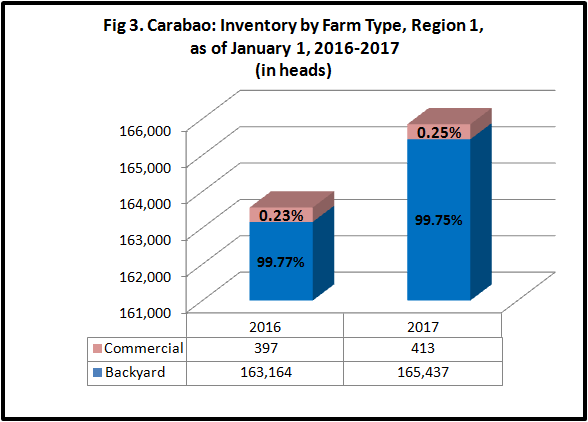
CATTLE
The region’s production of cattle was 14,445 metric tons liveweight. This increased by 1.13 percent as compared to 1st semester 2016. Region I ranked 3rd in the country’s cattle production of 130,821 metric tons with a share of 10.27 percent.
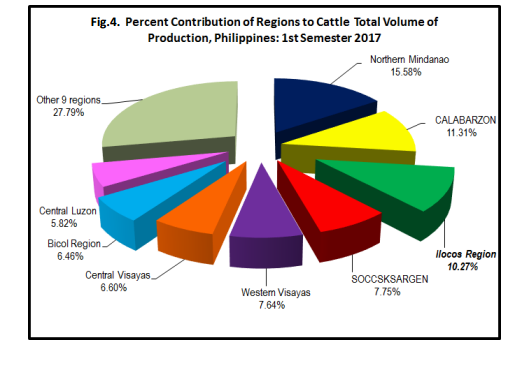
The total count of cattle as of January 1, 2017 was 300,323 heads. This was lower by 0.42 percent as compared to the same period last year. More were sold live due to encouraging price and high demand from viajeros to provinces outside the region. About 99.16 percent of the total inventory were in the backyard, while the remaining 0.84 percent were in the commercial farms.
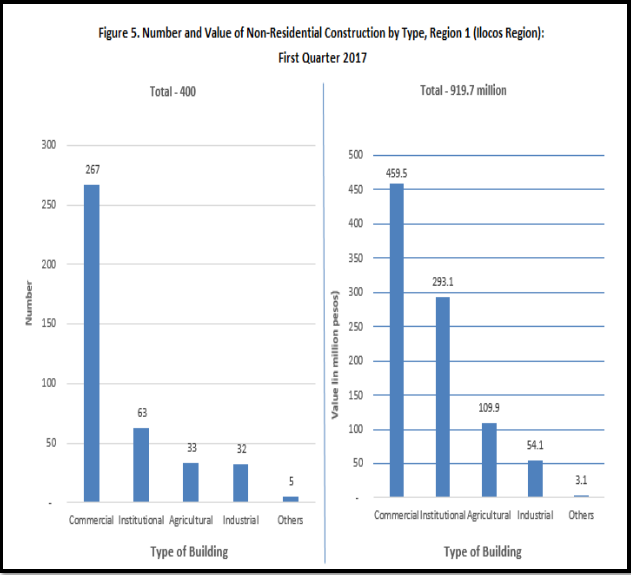
SWINE
Swine or hog production in Region 1 gained by 4.57 percent this 1st semester 2017 over last year’s level of 43,502 metric tons. The total production in the country was 1,087,735 metric tons liveweight. Region 1 ranked 10th among the top producers with a share of 4.18 percent.
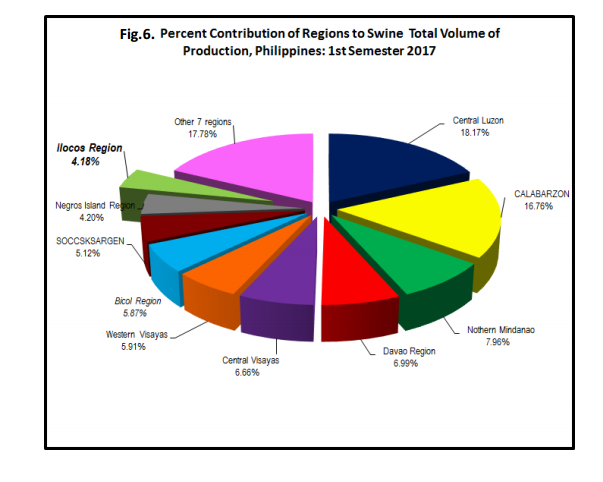
Total inventory of swine as of January 1, 2017 was 577,227 heads, higher by 3.93 percent than last year. Out of this total inventory, 81.70 percent were in backyard farms, while 18.30 percent were in commercial farms. The number of swine on backyard and commercial farms grew by 2.72 percent and 9.34 percent, respectively.
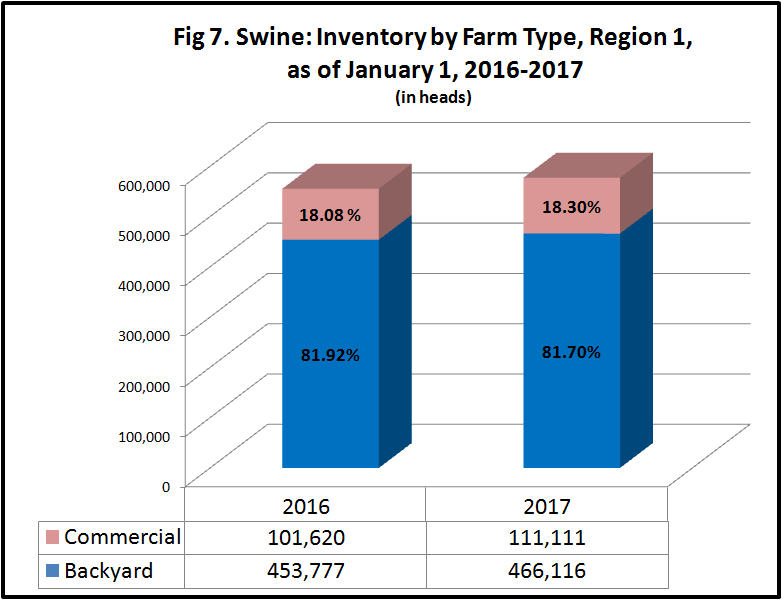
GOAT
Goat production was estimated at 5,180 metric tons equivalent to a drop of 2.41 percent as compared last year. Region 1 remained as the number one producer of goat in the country with a share of 13.90 percent to the national production of 37,259 metric tons.
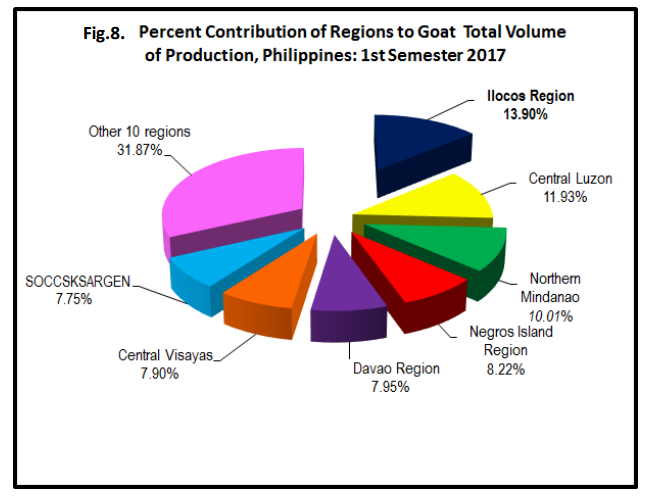
The number of goat in the region in backyard farms as of January 1, 2017 was 419,821 heads, a 4.83 percent increase as compared to same period last year. This contributed about 98.56 percent of the total goat inventory of the region. The commercial farms contributed about 1.44 percent of the total goat inventory. The number of heads in commercial farms declined by 11.44 percent.
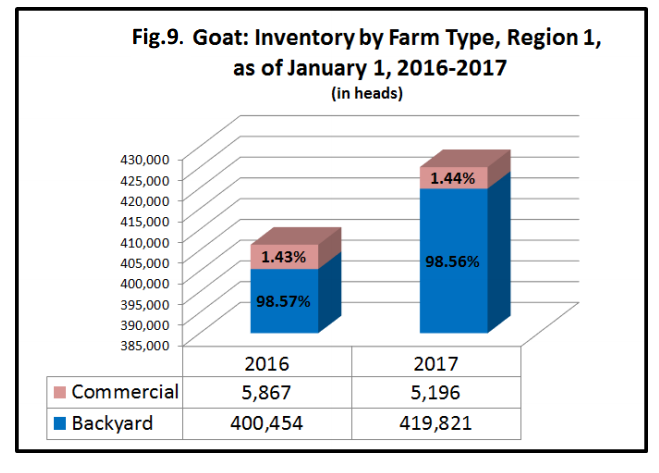
CHICKEN
Production of chicken in the region had a gain of 2.18 percent from 39,911 metric tons last 1st semester 2016 to 40,780 metric tons in 2017 of same period. Likewise, chicken egg production increased by 0.44 percent over last year’s level. Region 1 was among the top five producers of chicken in the country with a share of 4.70 percent.
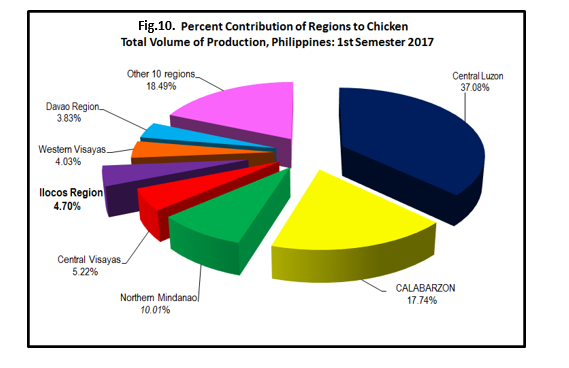
Broiler, layer and native chicken inventory posted decreases at the start of 2017. The share of native to the total chicken inventory was 50.42 percent, while broiler and layer shared 41.05 percent and 8.53 percent respectively.
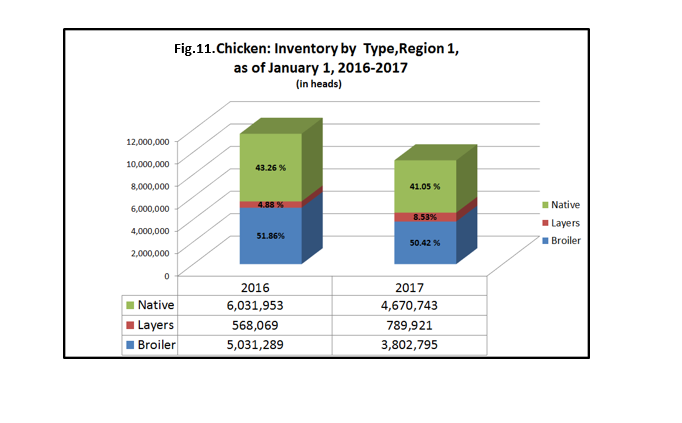
DUCK
The region’s duck production was 1,102 metric tons. This declined by 2.04 percent as compared to same period last year. Region 1 ranked 5th in the country’s total duck output of 32,216 metric tons with a contribution of 6.16 percent.
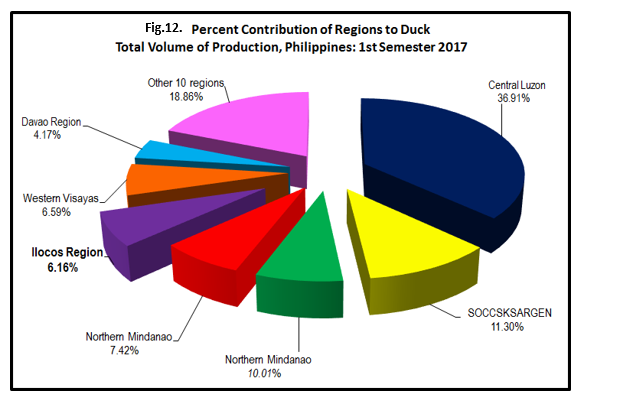
The backyard inventory of duck as of January 1, 2017 was 376,279 heads. It increased by 1.92 percent as compared to same period last year. On the other hand, the inventory of duck in commercial farms decreased by 76.90 percent as compared to last year’s level due to closure of big farms in Pangasinan. About 93.01 percent of the total duck inventory were in the backyard farms, while the remaining 6.99 percent were in the commercial farms.
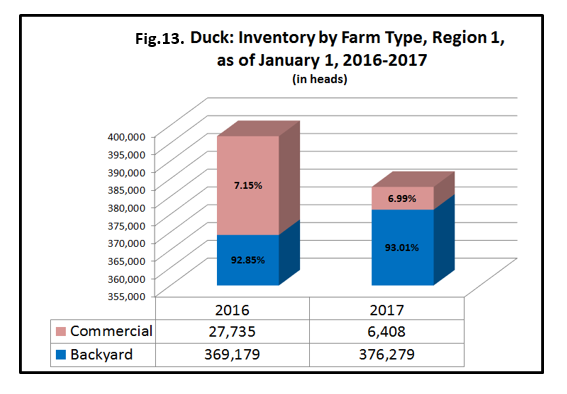
TECHNICAL NOTES
- Production. Refers to the volume of indigenous (locally-raised) animals disposed for slaughter which include animals exported or shipped-out for slaughter (in “head” and in “liveweight equivalent”).
- ·Livestock – farm animals kept or raised for consumption, work or leisure. In general, poultry is separated as a distinct group of farm animals. For purposes of census and surveys, livestock covers only those that are tended and raised by an operator.
- Poultry - a collective term for all domesticated avian for the purpose of food consumption or, the carcass of such avian dressed/processed for human consumption.
- Animal Inventory (also, Animal Population) – the number of domesticated animals in head present in the farm at specific reference date.
- Backyard Farm/Raiser- refers to any farm or household raising at least one head of animal or bird and does not qualify as a commercial farm.
- Commercial Livestock Farm/Operator - refers to any livestock operator or farm which operation satisfies at least one of the following conditions: a) at least 21 head of adults and zero young b) at least 41 head of young animals c) at least 10 head of adults and 22 head of young animals.
- Commercial Poultry Farm/Operator- refers to any poultry operator or farm which operation satisfies at least one of the following conditions: a) 500 layers or 1,000 broilers b) 100 layers and 100 broilers if raised in combination c) 100 head of duck regardless of age.
- Swine. A non-ruminant, cloven-footed animal belonging to family suidae with simple stomach, having a snout, large number of mammary glands, thin skin, and heavy bristles. It is also called hog or pig.
·
·
·
SOCRATES L. RAMORES
Regional Director

